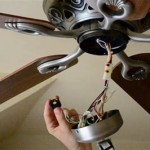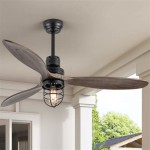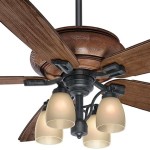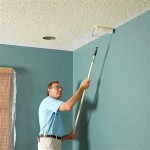How To Patch A Hole In A Ceiling
Ceilings can suffer damage from various causes, ranging from water leaks and accidental impacts to the simple wear and tear that comes with time. A hole in a ceiling, regardless of its size, is not only unsightly but can also lead to more significant problems if left unaddressed. These problems might include further water damage, pest infestation, or even structural weakening. Thus, understanding the process of patching a hole in a ceiling is a valuable skill for any homeowner or building manager.
The process of patching a hole in a ceiling involves several steps, each requiring careful attention to detail. The specific techniques and materials used will depend on the size of the hole, the type of ceiling material (e.g., drywall, plaster), and the desired aesthetic outcome. However, the core principles remain consistent: cleaning the damaged area, preparing the patching material, applying the patch, and finishing the surface to blend seamlessly with the surrounding ceiling.
Before commencing any repair work, it is critical to identify the cause of the damage. For example, if the hole resulted from a water leak, addressing the leak itself is paramount before patching the ceiling. Failure to do so will only lead to the recurrence of the problem and the eventual failure of the repair.
Key Point 1: Assessment and Preparation
The first crucial step is a thorough assessment of the damage. This involves determining the size and shape of the hole, the type of ceiling material, and the extent of any surrounding damage. This assessment will dictate the materials and techniques required for the repair.
Safety is also of paramount importance. Before working on any ceiling, ensure the power is turned off to any electrical fixtures in the immediate vicinity. Wear safety glasses to protect the eyes from falling debris and a dust mask to avoid inhaling dust particles. If the hole is large or the ceiling appears unstable, consider consulting a professional.
Once safety precautions are in place, prepare the area around the hole. Remove any loose or crumbling material from the edges of the hole. A utility knife or a scraper can be used to carefully trim away any jagged edges, creating a clean, stable surface for the patch to adhere to. This step is vital for ensuring a strong and durable repair.
Dust and debris should be thoroughly removed from the area using a brush or vacuum cleaner. A clean surface is essential for proper adhesion of the patching material. Consider wiping the area with a damp cloth to remove any remaining dust particles, but ensure the surface is completely dry before proceeding.
For smaller holes (less than a few inches in diameter), a simple patching compound may suffice. However, larger holes will require more robust support. In such cases, consider using a backing material, such as a piece of wood or metal, to provide a solid foundation for the patch. This backing material should be larger than the hole and securely fastened to the surrounding ceiling structure.
To secure the backing material, use screws or nails to attach it to the existing ceiling joists or framing. Ensure the backing material is flush with the surrounding ceiling surface. If necessary, shims can be used to level the backing material. This will create a stable and even surface for the patch.
Key Point 2: Patching the Hole
The next step is to apply the patching material. For small holes, use a ready-mixed patching compound or drywall mud. Apply the compound using a putty knife or a drywall knife, pressing it firmly into the hole to fill it completely. Overfill the hole slightly, allowing for shrinkage during the drying process.
For larger holes that utilize a backing material, the patching process is similar. Apply the patching compound over the backing material, ensuring it fills the entire hole and blends seamlessly with the surrounding ceiling. Multiple layers of compound may be necessary to achieve a smooth, even surface. Allow each layer to dry completely before applying the next.
When applying the patching compound, use smooth, even strokes to avoid creating ridges or bumps. Feather the edges of the compound outward, blending it into the surrounding ceiling surface. This will help to create a seamless transition between the patch and the existing ceiling.
Allow the patching compound to dry completely according to the manufacturer's instructions. Drying times can vary depending on the type of compound used and the environmental conditions. Avoid rushing the drying process, as this can lead to cracking or shrinking of the patch.
Once the patching compound is completely dry, sand the surface smooth using fine-grit sandpaper. Use a sanding block or a sanding sponge to avoid creating uneven surfaces. Sand the entire patched area, blending it seamlessly with the surrounding ceiling. Be careful not to damage the surrounding ceiling surface during the sanding process.
After sanding, remove any dust particles with a brush or vacuum cleaner. A clean surface is essential for the final finishing step.
Key Point 3: Finishing and Painting
The final step is to prime and paint the patched area. Priming is essential for ensuring proper adhesion of the paint and for preventing the patching compound from absorbing moisture from the paint. Apply a coat of primer to the entire patched area, extending it slightly beyond the edges of the patch.
Allow the primer to dry completely according to the manufacturer's instructions. Once the primer is dry, inspect the surface for any imperfections. If necessary, apply another thin layer of patching compound to fill any remaining imperfections and sand the surface smooth again.
Choose a paint that matches the existing ceiling color and sheen. If necessary, consult with a paint professional to ensure a perfect match. Apply the paint to the entire patched area, using a roller or a brush. Apply multiple coats of paint, allowing each coat to dry completely before applying the next.
When painting, use smooth, even strokes to avoid creating streaks or drips. Feather the edges of the paint outward, blending it into the surrounding ceiling surface. This will help to create a seamless transition between the patched area and the existing ceiling.
Allow the paint to dry completely according to the manufacturer's instructions. Once the paint is dry, inspect the finished surface for any imperfections. If necessary, apply another coat of paint to achieve a consistent color and sheen.
Proper ventilation is crucial during the priming and painting process. Open windows or use a fan to ensure adequate airflow. Wear a respirator mask to avoid inhaling paint fumes.
Once the patching is completed, it is crucial to maintain the repair. Inspect the area regularly for any signs of cracking, peeling, or water damage. Address any issues promptly to prevent further damage and ensure the longevity of the repair.
Patching a hole in a ceiling requires patience, attention to detail, and the use of appropriate materials and techniques. By following these guidelines, individuals can effectively repair damaged ceilings and restore their appearance and structural integrity.

3 Ways To Fix Holes In A Ceiling Wikihow

How To Repair A Hole In Your Ceiling Drywall

3 Ways To Fix Holes In A Ceiling Wikihow

How To Repair A Hole In Your Ceiling Drywall

Drywall Repair The Best Ceiling Hole Patch Is Youtube

How To Patch Drywall Hole On A Ceiling Diy Repair Tutorial Part 1 Installing Youtube

How To Patch A Hole In Textured Ceiling Ehow

How To Repair A Ceiling Building Hardware B Q

How To Patch And Repair A Hole In The Ceiling Diy Great Home Ideas

Repair A Hole In Plasterboard Ceiling R B Plastering Ltd








